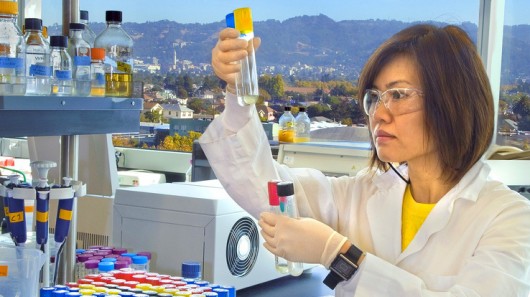New yeast strain produces ethanol more efficiently
By Grant Banks
16:47 January 2, 2011

Lawrence Berkeley National Laboratory researchers are using the tools of synthetic biology to engineer new microbes as an alternative to yeast that can quickly and efficiently forment complex sugars into advanced biofuels. Photo credit: Lawrence Berkeley National Laboratory - Roy Kaltschmidt
The biofuel industry stands to benefit from the development of a new variety of yeast which produces ethanol from plant products more efficiently. Engineered by combining two existing yeast species, the new strain can simultaneously consume two types of sugar commonly found in plants to produce ethanol.
Researchers combined genes from one yeast species that naturally processes glucose – a six-carbon sugar that is relatively easy to ferment – and another that can process xylose – a five-carbon sugar that has been much more difficult to utilize in ethanol production.
Another breakthrough was achieved by finding a way for the organism to more efficiently process cellobiose, a complex sugar found in plant cell walls consisting of two linked glucose molecules.
The breakdown of cellobiose and the fermentation of xylose had previously been large stumbling blocks in efficient biofuel production.
The team from the University of Illinois, the Lawrence Berkeley National Laboratory, the University of California and energy company BP used the yeast species Saccharomyces cerevisiae as the building block for the research. This species has been used in baking and brewing for centuries and has already been utilized extensively in biofuel production. It is a relatively efficient fermenter of the sugar molecule glucose.
One of the factors limiting the efficiency of S. cerevisiae in biofuel production was its system of processing of cellobiose which consists of two glucose sugars linked together. Cellobiose was previously converted to glucose outside the yeast cell before entering through glucose transporters for conversion to ethanol. The researchers added a cellobiose transporter that allowed the yeast to transfer cellobiose directly into the cell for conversion to glucose then ethanol.
Another problem overcome was the inability of S. cerevisiae to process the complex sugar xylose, a common component of leaves and stems. To solve this hurdle three genes from the yeast species Picchia stipitis, a natural fermenter of xylose, were introduced.
According to Yong-Su Jin, a professor of food science and human nutrition at Illinois, the slow metabolism of xylose has traditionally added significantly to the cost of biofuel production. A large problem with yeasts altered to take up xylose is that they will suck up all the glucose in a mixture before they will touch the xylose. The glucose transporter on the surface of the yeast prefers to bind to glucose.
"It's like giving meat and broccoli to my kids. They usually eat the meat first and the broccoli later," Jin said.
Finally, the team used "evolutionary engineering" to optimize the new strain's ability to utilize xylose. They also engineered an artificial "isoenzyme" that balanced the proportion of two important cofactors so that the accumulation of xylitol, a byproduct of xylose conversion, could be minimized.
"If you do the fermentation by using only cellobiose or xylose, it takes 48 hours," postdoctoral researcher and lead author Suk-Jin Ha said. "But if you do the co-fermentation with the cellobiose and xylose, double the amount of sugar is consumed in the same amount of time and produces more than double the amount of ethanol. It's a huge synergistic effect of co-fermentation."
The new yeast strain is at least 20 percent more efficient at converting xylose to ethanol than other strains, making it "the best xylose-fermenting strain" reported in any study.
Ha believes that the cost benefits of this advance in co-fermentation are very significant.
"We don't have to do two separate fermentations. We can do it all in one pot. And the yield is even higher than the industry standard. We are pretty sure that this research can be commercialized very soon."
Copyright © gizmag 2003 - 2010 To subscribe or visit go to: http://www.gizmag.com